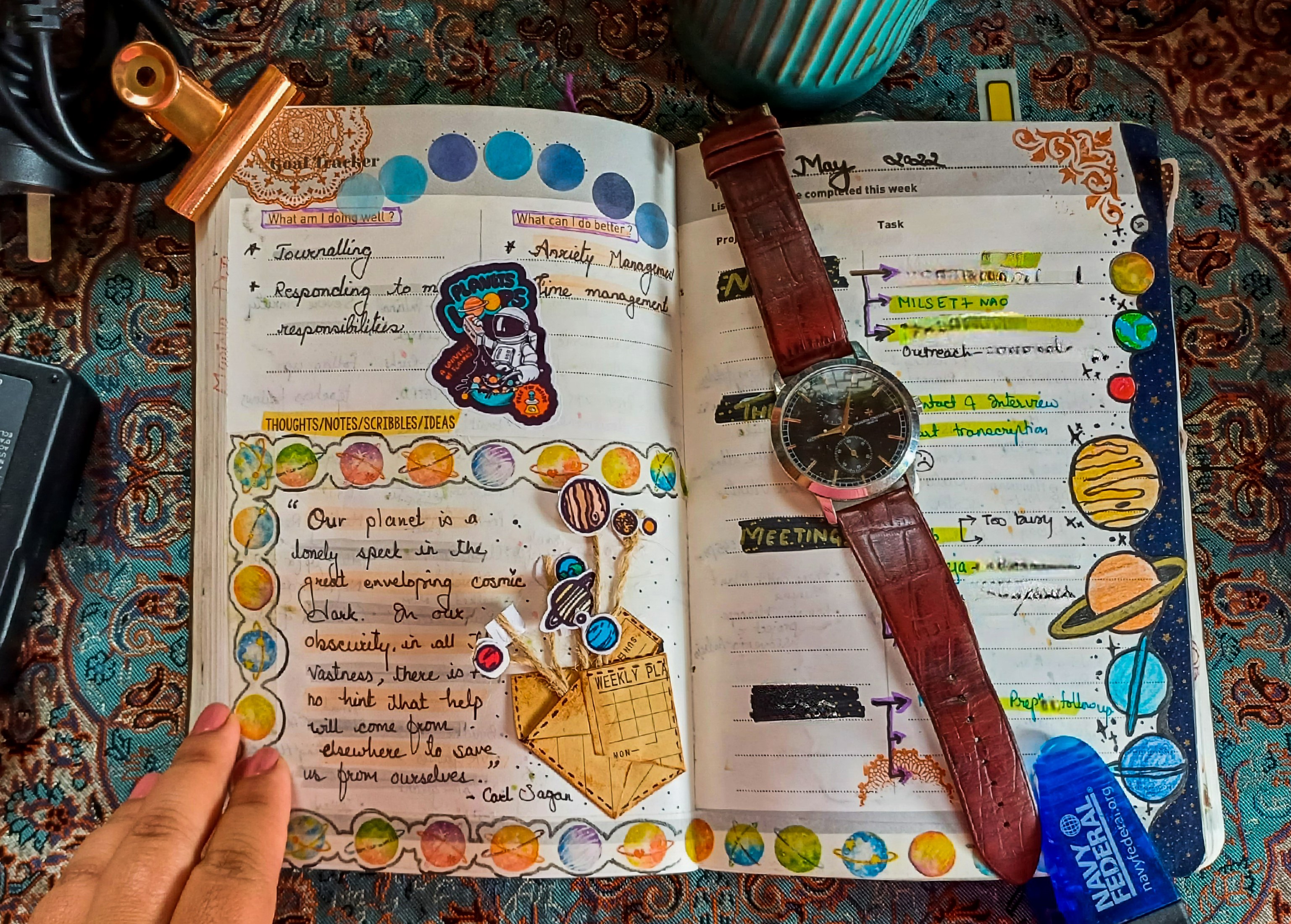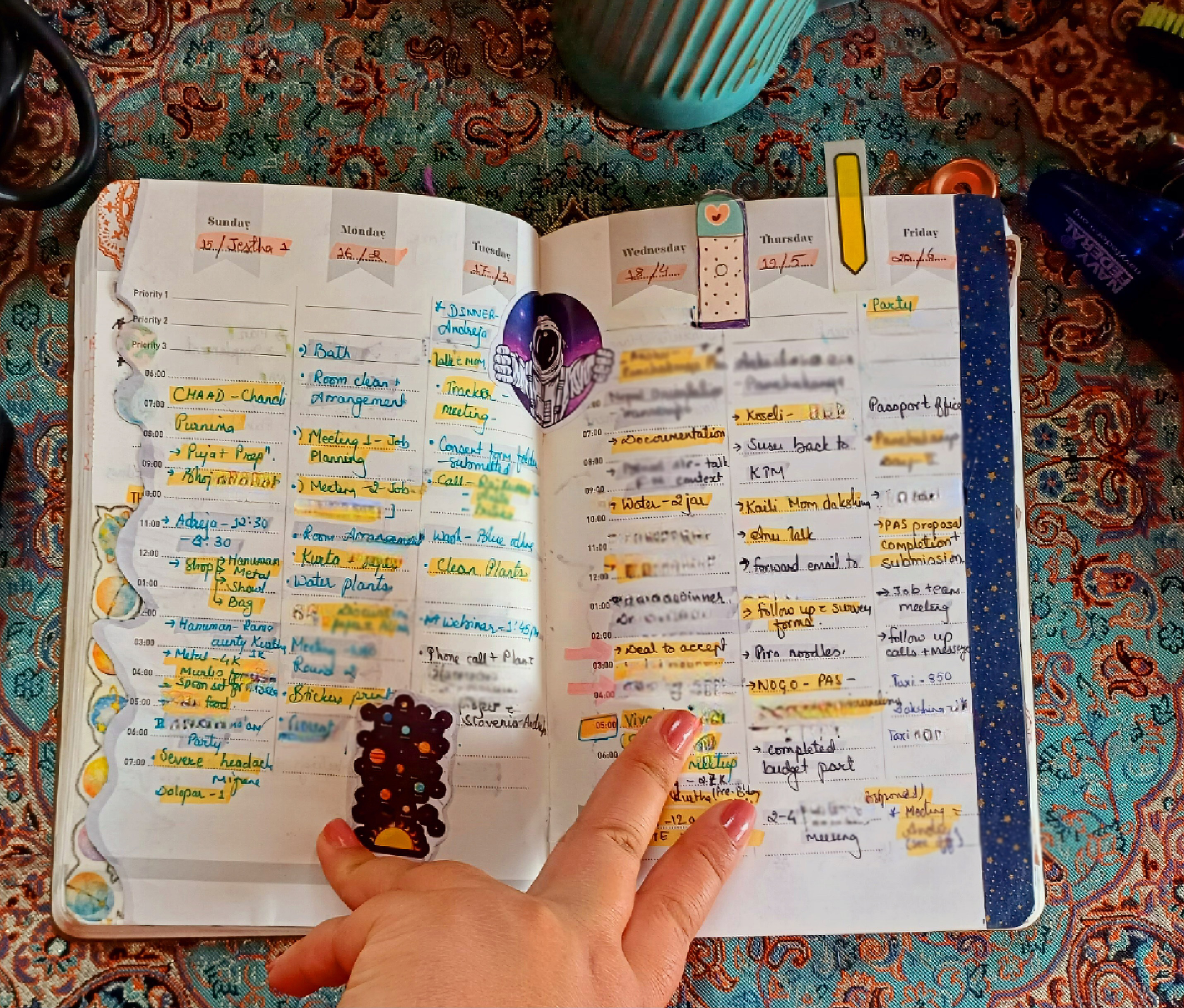
Manisha Dwa had always been a lowkey hoarder, collecting astronomy-themed stationeries, notebooks, notepads, stickers and other assortments. When she stumbled upon a new planner on Instagram, she ordered it right away and started using it, added it to her collection and started journaling too.
Like Dwa, many urban youths have also been known to have gravitated towards this new culture of using planners and organisers or journals to keep track of their day or schedule.
Amid the Covid pandemic in 2020, many individuals found themselves confined to their homes. With too much time on their hands, many were grappling with time management challenges.
Sakrita Maharjan, a college student at that time, felt that same dilemma until she discovered the planners online. “I discovered planners from Bhav and Manan Planners. So, I started using them and it gave me a sense of achievement. I felt like it was getting things done.”
They are now considered indispensable tools for individuals who are hustling and navigating the demands of the modern workplace.
In this day and age, where the workplace is seeing a younger workforce and a rise in hustle culture, the role of planners and organisers has become increasingly essential. The increasing trend of physical and online stores dedicated to planners and organisers is evidence of this. These businesses and startups are capitalising on the rising demand by dedicating specific sections or even entire businesses to cater to this need. And what is helping them is the people are loving it.
Planning a business
Manan Planners is the brainchild of Diva Shrestha. During her time in the United States of America, she regularly used planners. But when she returned to Nepal in 2018, she could not find one. That led her to develop a planner, both on paper and digitally, initially starting with a weekly planner that she shared among her friends and colleagues.

When she started, her goal was simple – promoting a planner culture in Nepal.
“The concept of using a planner is still very new in Nepal. People do not know about it or have an idea about how to use it. So with Manan, that is what we tried to work on and bring this concept of productivity among the common people,” says Diva Shrestha.
Together with her brother, Dibeev Bhakta Shrestha, and a friend, Aakash Shrestha, Diva spent six months on research and design, aiming to create planners that incorporated Nepali elements and stood out in the market.
“The planners were designed to be unique, easy to use, and highly useful, with monthly, weekly, and daily breakdown layouts,” she says
Different from the many dated and bulky corporate-looking planners and organisers available in the market, Manan had a different appeal.
“The vintage-looking cover and the fact that the notebook was not dated, made me like their planner even more. I could start my new year any day. And did not have to wait for Baisakh 1 or January 1, to start being productive,” says Dwa.

The blank pages of the planner gave people freedom. “It had monthly, weekly and just blank lining sections that I could use as I wanted,” she adds.
But everyone has their unique way of using planners.
Sakrita Maharjan also used planners. But though she started as a customer, she felt that something was still missing. So, she conceptualised the kind of planner she wanted and then customised a planner for her own needs.
“I first researched and designed the planner digitally, and when I felt that it was good I also shared it with my family and friends to get the review,” says Maharjan.
This initial foray into planner creation sparked a passion that would soon become a thriving business as she co-founded Lets Organize which she runs with her sister, Iju.
“We started online, on Instagram. And after I graduated, we took this venture more seriously and started working full-time. We got momentum, and so decided to venture into it and brainstormed more ideas,” says Maharjan.
As a part of her idea, they started targeting individuals in their 20s to 30s, particularly those seeking weekly planning assistance. So their weekly planners gained popularity and soon they expanded with financial planners that were received equally well, shares Maharjan.
“The working population seem to struggle to tackle mental health challenges and burnout. So, we have also included aspects like gratitude and self-care in our designs, including different sections to track water intake, appointment scheduling, reading trackers and prioritising to-do lists. It has appealed to a wide range of working professionals and bookworms,” says Maharjan.

Importance of planners
The idea of planners and organisers and how to use them has not yet flourished in Nepal. Both Shrestha and Maharjan share that they first started their idea digitally, being inspired by the many ventures that were already online. And both eventually decided to bring them into shape, on paper.
Undoubtedly, their ideas would have been more risk-free to keep it online. But the reason, they say, they decided to keep paper as their base is because writing one’s thoughts down and things to do has been known to increase productivity, give a sense of achievement and give a bigger picture. It has been used to increase the user’s holistic growth with much-needed privacy.
And people, with access to the internet, a more younger generation have been more attracted towards it. But, on the ground, both Let’s Organize and Manan observe that the working population have been making the most of their planners and organisers.
For both brands, one of the main driving forces was the desire to address the niche aspect of helping people become more productive and to assist individuals in long-term planning. And they kept their names to match their core message too.
Manan means to reflect within–introspection and self-reflection– for personal progress. Let’s Organize was to simply send the message that they want to help in organising and starting the movement.
Manan started in 2019 and Let’s Organize in 2021, but despite the growing customer base, they share that the market is rather small and many still have not uncovered the full potential of the planners and organisers.
“In most developed countries, this is an old concept. But here, the concept is just a seed,” says Shrestha.

Customising is a big hit
Both Shrestha and Maharjan say they have observed the Nepali audience is drawn towards being able to customise their planners and organisers which deviates from the primary concept of planners and organizers.
“Planners and organisers have become sought-after items these days. Students going abroad buy them along with working professionals. People also feel it is a good thing to gift people. But since the intention is to gift, they want to customise it, sometimes from Pinterest and other times from adding a quote, changing colours, or adding a photo or graphics,” says Maharjan saying they are not that economical for them to customise for everyone.
Aakash from Manan Planners also says that customisation request is a common for them as well.
“Some request us to customise the covers, some even ask us to change the layout. But though we try to accommodate their requests only some requests are doable. However, we have included their feedback and changed the layout for the second iteration of our yearly planners.”
But what the two groups have been doing is accommodating specific needs in bulk orders, and Manan gets more corporate orders than the Let’s Organize duo.
For the latter, Maharjan says, “We have kept the option for handwritten notes and unique packaging options.”
Other than that they also make gift boxes or packages or just couple them with something else on special occasions for example during Valentine’s Day and Mother’s Day.
Let’s Organize, she says, has also been working on collaborations with other organisations like Lumiere Nepal to create customised vision boards for its customers.

Planning the next move
Looking ahead, they plan to expand their market by branching out into notebooks, notepads, and other related products.
As the business grows, the Maharjan sisters have found themselves handling various aspects, including social media management, marketing, events, logistics, creative design, and printing. So, now to cope with the workload, they plan to expand their team, particularly in the areas of social media management and logistics.
Despite the current small size of the market, the makers believe in its significant potential and identify numerous untapped areas for growth and expansion.
“Though there are some other ventures that have introduced planners and organisers, we embrace the healthy competition, and believe that choice is a plus point for the customers,” says Aakash.
As for Manan, they are planning their next iteration already, and will soon make the plans public. On the other hand, Let’s Organize is also thinking of possible expansion and opening a physical store. So far both have only operated with their online stores.
But despite that, teaching customers about how to effectively use planners and organisers remains a priority, they say.




















